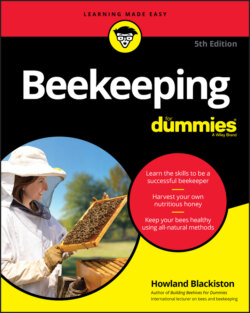Читать книгу Beekeeping For Dummies - Howland Blackiston - Страница 63
Field bees
ОглавлениеWhen the worker bee is a few weeks old, she ventures outside the hive to perform her last and perhaps most important job — to collect the pollen and nectar that will sustain the colony. With her life half over, she joins the ranks of field bees until she reaches the end of her life.
It’s not unusual to see field bees taking their first orientation flights. The bees face the hive and dart up, down, and all around the entrance. They’re imprinting the look and location of their home before beginning to circle the hive and progressively widening those circles, learning landmarks that ultimately will guide them back home. At this point, worker bees are foraging for pollen (see Figure 2-8), nectar, water, and propolis (resin collected from trees).
Courtesy of USDA-ARS, Stephen Ausmus
FIGURE 2-8: This bee’s pollen baskets are filled. She can visit ten flowers every minute and may visit more than 600 flowers before returning to the hive.
Foraging bees visit 5 million flowers to produce a single pint of honey. They forage a 2- to 3-mile radius from the hive in search of food (even more if necessary for water), and propolis. That’s the equivalent of several thousand acres! So don’t think for a moment that you need to provide everything they need on your property. They’re ready and willing to travel.
Foraging is the toughest time for the worker bee. It’s difficult and dangerous work, and it takes its toll. They can get chilled as dusk approaches and die before they can return to the hive. Sometimes they become a tasty meal for a bird or other insect. You can spot the old girls returning to the hive. They’ve grown darker in color, and their wings are torn and tattered. This is how the worker bee’s life draws to a close working diligently right until the end.
